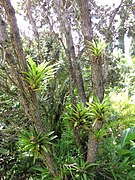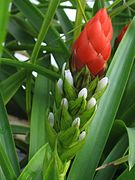Guzmania monostachia
Appearance
| Guzmania monostachia | |
|---|---|

| |
| Scientific classification | |
| Kingdom: | Plantae |
| Clade: | Tracheophytes |
| Clade: | Angiosperms |
| Clade: | Monocots |
| Clade: | Commelinids |
| Order: | Poales |
| Family: | Bromeliaceae |
| Genus: | Guzmania |
| Species: | G. monostachia
|
| Binomial name | |
| Guzmania monostachia (Linnaeus) Rusby ex Mez
| |
| Synonyms[2] | |
| |
Guzmania monostachia is an epiphytic species in the genus Guzmania. Also known as a West Indian tufted airplant,[3] this species is native to South America (Bolivia, Brazil, Colombia, Ecuador, Peru, Venezuela), Central America, the West Indies and Florida.[2][4][5][6][7][8][9][10][11][12] The species is also reportedly naturalized in Hawaii.[13]
Guzmania monostachia is notable as it is a facultative CAM species, converting from C3 photosynthesis to CAM under high light treatment or drought stress as a protective measure.[14]
Cultivars
[edit]Gallery
[edit]-
Guzmania monostachia growing at the Enchanting Floral Gardens of Kula, Maui.
-
A close-up of the plant
-
A drawing of the Guzmania monostachia from the "Collectanea botanica or Figures and botanic Illustrations of rare and curious exotic Plants" by John Lindley.
References
[edit]- ^ "NatureServe Explorer 2.0". explorer.natureserve.org. Retrieved 13 November 2022.
- ^ a b Kew World Checklist of Selected Plant Families[permanent dead link]
- ^ "PLANTS Profile for Guzmania monostachia (West Indian tufted airplant) | USDA PLANTS". PLANTS Database. United States Department of Agriculture: Natural Resources Conservation Service. 2013. Archived from the original on 27 May 2013. Retrieved 9 June 2013.
- ^ Krömer, Thorsten; Kessler, Michael; Holst, Bruce K.; Luther, Harry E.; Gouda, Eric J.; Ibisch, Pierre L.; Till, Walter; Vásquez, Roberto (1 October 1999). "Checklist of Bolivian Bromeliaceae with Notes on Species Distribution and Levels of Endemism". Selbyana. 20 (2): 201–223. ISSN 2689-0682. JSTOR 41760025.
- ^ Martinelli, Gustavo; Vieira, Cláudia Magalhães; Gonzalez, Marcos; Leitman, Paula; Piratininga, Andréa; Costa, Andrea Ferreira da; Forzza, Rafaela Campostrini (January 2008). "Bromeliaceae da Mata Atlântica Brasileira: lista de espécies, distribuição e conservação" [Bromeliaceae of the brazilian Atlantic Forest: checklist, distribution and conservation]. Rodriguésia (in Brazilian Portuguese). 59 (1): 209–258. doi:10.1590/2175-7860200859114. JSTOR 23499386.
- ^ Holst, Bruce K. (1 February 1994). "Checklist of Venezuelan Bromeliaceae with Notes on Species Distribution by State and Levels of Endemism". Selbyana. 15 (1): 132–149. ISSN 2689-0682. JSTOR 41759858.
- ^ Luther, H.E. "Bromeliaceae of the United States (excluding Puerto Rico and the Virgin Islands)" (PDF). Marie Selby Botanical Gardens.
- ^ Acevedo-Rodríguez, P. & Strong, M.T. (2005). Monocotyledons and Gymnosperms of Puerto Rico and the Virgin Islands. Contributions from the United States National Herbarium 52: 1-415.
- ^ Nelson Sutherland, C.H. (2008). Catálogo de las plantes vasculares de Honduras. Espermatofitas: 1-1576. SERNA/Guaymuras, Tegucigalpa, Honduras.
- ^ Hokche, O., Berry, P.E. & Huber, O. (eds.) (2008). Nuevo Catálogo de la Flora Vascular de Venezuela: 1-859. Fundación Instituto Botánico de Venezuela.
- ^ Martinelli, G., Magalhães Vieira, C., Gonzalez, M., Leitman, P., Piratininga, A. Ferreira da Costa, A. & Campostrini Forzza, R. (2008). Bromeliaceae da Mata Atlântica Brasileira: lista de espécies, distribuição e conservação. Rodriguésia; Revista do Instituto de Biologia Vegetal, Jardim Botânico e Estaçao Biologica do Itatiaya 59: 209-258.
- ^ Acevedo-Rodríguez, P. & Strong, M.T. (2012). Catalogue of seed plants of the West Indies. Smithsonian Contributions to Botany 98: 1-1192.
- ^ Starr Environmental, Plants of Hawaii, Guzmania monostachia (West Indian tufted airplant)
- ^ Maxwell, C; Griffiths H; Young AJ (1994). "Photosynthetic acclimation to light regime and water stress by the C3-CAM epiphyte Guzmania monostachia: gas-exchange characteristics, photochemical efficiency and the xanthophyll cycle". Functional Ecology. 8 (6): 746–754. doi:10.2307/2390234. JSTOR 2390234.
- ^ BSI Cultivar Registry Archived 2009-12-02 at the Wayback Machine Retrieved 11 October 2009
External links
[edit]- US Department of Agriculture plants profile
- Atlas of Florida Vascular Plants, West Indian Tufted Airplant, Guzmania monostachia
- Zipcodezoo Guzmania_monostachia, photo of herbarium specimen collected in Costa Rica
- Hawaii Tropical Botanical Garden, Guzmania monostachia Archived 2014-08-10 at the Wayback Machine
- Tropical Plant Book, Guzmania monostachia in Ecuador




